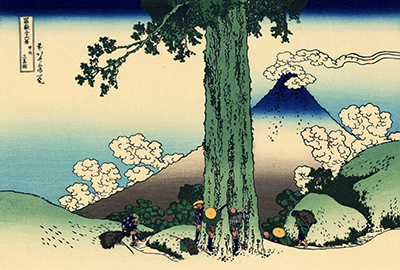Hokusai
Mishima Pass in Kai Province by Hokusai
Mishima Pass in Kai Province or Kōshū Mishima goe, is one of the amazing prints from Katsushika Hokusai’s famous series Thirty-six Views of Mount Fuji also known as Fugaku sanjūrokkei. Hokusai was born in 1670 in Japan, Edo district and died in 1849 and was buried in Seikyō-ji in Tokyo (Taito Ward).
The print Mishima Pass in Kai Province was produced in ca. 1830-1832 during the Edo period of between 1615 and 1868 in Japan. It was printed on a Polychrome woodblock print; ink and color on paper with dimensions of 9 3/4 × 14 3/4 in. (24.8 × 37.5 cm) and classified as a print. Expressing their exuberance and triumph in the print Mishima Pass in Kai Province, Hokusai, depicted joyous three travellers who had reached the ancient site of the cryptomeria tree and embrace its enormous trunk. Hokusai reveals his empathy for pilgrims by painting small persons embracing the massive trunk of the tree.
Mishima Pass is believed to be around the present Kagosaka Pass. From the print other travellers are resting after the long tiring journey while others are embracing the enormous tree trunk. The rugged bark of the trees expresses the fact that it was an old monumental tree. Mount Fuji is seen on the solid clouds on the heads and lower sides. The Ukiyo-e style on this woodblock has employed the gradation of three colours in an artistic manner. In his later postscripts Hokusai believed that he could have done better in the art to the extent of bringing to life the images he painted with his brush strokes, if he could have lived up to the age of 150-years-old.
He started painting at merely four-years-old and joined the art library and bookshop as an apprentice doing stone cravings at the age of 18-years-old. He further honed his artistic skills by joining the Tawaraya School and adopted the name, Tawaraya Son. However, he quit the school ties and passed on the name to another student and adopted another name Hokusai Tomiso and started painting as an independent artist. By 1800, he was using the name for other reasons other than just portraiture. Since that time Hokusai has achieved greatness, especially as documented in his series Thirty-six Views of Mount Fuji where he made thirty-six prints from various locations and during different seasons to represent the unique relationship between man and the environment.
